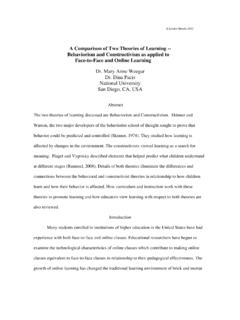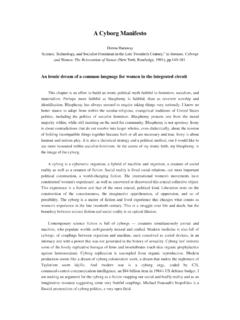Transcription of Chapter 13 - Vaccination Mandates: The Public Health ...
1 13 Vaccination Mandates: The Public Health Imperative and Individual Rights KEVIN M. MALONE AND ALAN R. HINMAN In 1796, Edward Jenner demonstrated that inoculation with material from a cowpox (vaccinia) lesion would protect against subsequent exposure to small pox. This began the vaccine era, although it was nearly 100 years until the next vaccine (against rabies) was introduced. In the twentieth century , many new vaccines were developed and used, with spectacular impact on the occurrence of disease. The Centers for Disease Control and Prevention (CDC) declared vaccinations to be one of the 10 great Public Health achievements of the twen tieth ,2 This Chapter describes the impact of vaccines in dramatically reducing infec tious diseases in the United States, the role of mandatory Vaccination in achiev ing that impact, and the constitutional basis for these mandates.
2 The Chapter also briefly reviews the federal government s role in immunization practices. BACKGROUND Concept for Community Disease Prevention Garrett Hardin s classic essay The Tragedy of the Commons3 describes the chal lenges presented when societal interest conflicts with the individual s interest. Hardin notes the incentives present when the cattle of a community are com 262 Vaccination MANDATES 263 mingled in a common pasture. At capacity, each owner still has an incentive to add additional cattle to the common because even though the yield from each animal decreases with the addition of more cattle, this decrease is offset for the individual owner by the additional animal. With this incentive, individual own ers continue to add cattle to the commons to reap their individual benefit, leading to the inevitable failure of the common from overgrazing.
3 The community in terest in maximizing food production, therefore, can be achieved only by placing controls on the interests of the individual owners in favor of those of the community. Analogously, a community free of an infectious disease because of a high Vaccination rate can be viewed as a common. As in Hardin s common, the very existence of this common leads to tension between the best interests of the individual and those of the community. Increased immunization rates result in significantly decreased risk for disease. Although no remaining unimmunized individual can be said to be free of risk from the infectious disease, the herd effect generated from high immunization rates significantly reduces the risk for disease for those individuals.
4 Additional benefit is conferred on the unimmuni zed person because avoidance of the vaccine avoids the risk for any adverse reactions associated with the vaccine. As disease rates drop, the risks associated with the vaccine come even more to the fore, providing further incentive to avoid immunization. Thus, when an individual in this common chooses to go unimmunized, it only minimally increases the risk of illness for that individual, while conferring on that person the benefit of avoiding the risk of vaccine-induced side effects. At the same time, however, this action weakens the herd effect protection for the entire community. As more and more individuals choose to do what is in their best individual interest, the common eventually fails as herd immunity disappears and disease outbreaks occur.
5 To avoid this tragedy of the commons, legal requirements have been imposed by communities (in recent times, by states) to mandate particular vaccinations . Vaccine Safety and Effectiveness Vaccines are safe and effective. However, they are neither perfectly safe nor perfectly effective. Consequently, some persons who receive vaccines will be injured as a result, and some persons who receive vaccines will not be protected. Most adverse events associated with vaccines are minor and involve local sore ness or redness at the injection site or perhaps fever for a day or so. Rarely, however, vaccine can cause more serious adverse events. Whether an adverse event that occurs after Vaccination was caused by the vaccine or was merely temporally related and caused by some totally independent (and often unknown or unidentified) factor is often difficult to ascertain.
6 This is particularly problem atic during infancy, when a number of conditions may occur spontaneously. In 264 CONTROL AND PREVENTION a given instance, determining whether vaccine was responsible may be impos Particularly when dealing with rare events, large-scale case control stud ies or reviews of comprehensive records of large numbers of infants may be necessary to ascertain whether those who received a vaccine had a higher in cidence of the event than those who did not. The CDC operates an extensive linked database involving several large Health -maintenance organizations. This Vaccine Safety Datalink project includes more than 6 million persons (approx imately 2% of the population) and has proved invaluable for attempting to determine Decisions about use of vaccines are based on the relative balance of risks and benefits.
7 This balance may change over time. For example, recipients of oral polio vaccine (OPV) and their close contacts have a risk of developing paralysis associated with the vaccine of 1 in approximately every million doses of vaccine distributed. This risk is small and was certainly outweighed by the much larger risk for paralysis from wild polioviruses at the time they were circulating in the United States. However, because wild polioviruses no longer circulate in the United States and the risk of importation of wild viruses has been greatly reduced by the global effort to eradicate polio, the balance has shifted. There has not been a case of paralysis in the United States from indigenously acquired wild poliovirus since 1979, and the entire Western Hemisphere has been free from wild poliovirus circulation since The Advisory Committee on Im munization Practices (ACIP), an advisory group to the CDC, recommended, in 1997, that children should receive a sequential schedule with two doses of in activated polio vaccine (IPV) (which carries no risk for paralysis but has slightly less effect in preventing community spread of wild poliovirus), followed by two doses of OPV.
8 In 2000, the recommendation was made to switch to an all-IPV An important characteristic of most vaccines is that they provide both indi vidual and community protection. Most of the diseases against which we vac cinate are transmitted from person to person. When a sufficiently large propor tion of individuals in a community is immunized, those persons serve as a protective barrier against the likelihood of transmission of the disease in the community, thus indirectly protecting those who are not immunized and those who received vaccine but are not protected (vaccine failures). One commentator has suggested that a social contract exists among parents to immunize their children not only to provide them individual protection, but also to contribute to the protection of other children who cannot be immunized or for whom the vaccine is not The proportion of the population that has to be immune to provide this herd immunity varies according to the infectiousness of the agent.
9 For poliomyelitis, that proportion is considered to be on the order of 80%, whereas for measles it exceeds 90%. When a community has a high level of Vaccination , an individual might decide Vaccination MANDATES 265 to not be vaccinated to avoid the small risk for adverse events while benefitting from the Vaccination of others. Of course, if a sufficient number of individuals make this decision, the protection levels in the community decline, the herd immunity effect is lost, and the risk of transmission rises. Impact of Vaccines The introduction and widespread use of vaccines have profoundly affected the occurrence of several infectious diseases. Smallpox was eradicated from the world onset of the last naturally occurring case was in 1977 and Vaccination against smallpox stopped.
10 Poliomyelitis is on the verge of eradication (the last indigenous case in the United States associated with wild virus occurred in 1979, and only 20 to 30 countries were still reporting transmission as of mid-2001). Because approximately 11,000 infants are born every day in the United States, the need to ensure that children continue to be protected is ongoing. In addition, a continuing threat exists of importation of disease from other countries. In the United States, infants and young children are currently vaccinated against 11 diseases: diphtheria, Haemophilus influenzae type b, hepatitis B, measles, mumps, pertussis, poliomyelitis, rubella, Streptococcus pneumoniae, tetanus, and In states with high risk for hepatitis A, children are also vaccinated against this disease.















